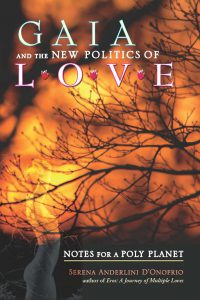Dear Earthlings:
The EcoSex course at U Conn is complete. It was a great experience. We spent time reading amazing books. And here we resume posts to be shared with you. Thinking out of the box and across disciplines. Students had been sending their responses in, with discussion questions. In class, we did connected the dots: a holograph of what we’ve read together, the “required readings.” Multiple perspectives and good synergy. Here, we offer a glimpse. Lisa Diamond’s Sexual Fluidity was one of two cultural-theory theory books. We got five responses: from Adam, Michael, Alissa, John, and Rhiann.
Here is John’s take:
I found this book to be very interesting, albeit a little bizarre in the self-referential aspect. As a male, reading a book that declares its intention to broaden the horizons of female
sexual identity, it was hard for me not to read it with my own experiences in mind.
Pretty much universally, I liked reading it. Lisa Diamond has a nice voice that makes her concepts easy to understand, however they are a bit long winded. She makes a compelling argument for looking at sexuality, females in particular, as a fluid rather than an identifiable label such as heterosexual, homosexual, or bisexual. Being the big grammar nerd that I am, I’m typically of the opinion that if you have sexual contact with only the opposite sex, you are heterosexual. If you have sexual contact with only the same sex, you are homosexual. If you have sex with both, then you are bisexual. I don’t see the problem with this classification linguistically, but the problem with “bisexuality” as a concept is that it is culturally understood as a transitional form of sexuality, rather than an actual category. I can’t find the page number, but there’s a section where Diamond asks the reader to identify which of her examples comes off as bisexual, and I would say all of them. I don’t find anything derogatory with saying that. It’s just the word itself for me. I identify as heterosexual because I cannot ever see myself in a sexual relationship with another man. In a world and in a life with so many uncertainties, I’m at least glad to have that down.
What’s the real goal of the book’s reorientation of labels? At the end of the day, if “the women who kept the same identity for the whole ten years proved to be the smallest and most atypical group,” (65), then aren’t we all really sort of sexually fluid? Or just the women? What’s the point of sexual identity if that’s the case? We seem to be moving in a direction of no labels: an area where identity is so entirely individual and personal that there’s nothing substantial there to replace it.
That being said, I can appreciate fully the value of her science and the book’s purpose. Because life doesn’t necessarily follow logical or clear-cut lines (like along grammatical boundaries) so why should sexuality? No one wants to be looked at as “developing” if they’re settled into a bisexual (or as Diamond calls it, non-exclusive sexuality) framework that they believe is a permanent state of being. Nor do they want to be stigmatized for being “confused” if “queer” will give them more credibility in the alternative sexuality community.
But I don’t feel satisfied with this book. It seems to be the inverse of Dr. Anapol’s “The Seven Natural Laws of Love.” Anapol’s Laws can really apply to any situation. All of her laws are applicable to family, friends, lovers, animals, even the Earth, but there’s a distinguishable difference between the love one feels for a parent and the love one feels for a lover. It’s pretty universally established that one cannot love a parent in the same way as a lover. Diamond’s “Sexual Fluidity” seems to follow this same path, just in a physical, rather than esoteric, way. For example, Diamond’s subjects have to “decide whether their sexual identity was better categorized by patterns of “love” or patterns of “lust,” and they had to fore- cast what sort of relationships they might desire in the future,” (77). She goes on to conclude that lesbian or bisexual identities are more about degree of attachment (love vs. lust) than about a personal commitment to one sexual exclusivity or the other.
I don’t even know how to formulate my question. Ok, so sex doesn’t matter when determining a mate. Or at least, it shouldn’t. I really enjoyed the chapter “Attractions to ‘the Person, Not the Gender,’” because it opened all sorts of new understandings about falling in love with a person, with their gender in the background as opposed to the conventional “boy meets girl” narrative. I think this is important, and it would be interesting to see a comparative study on men.
I think I’m in the minority of men in that I don’t typically like to hookup. The few times I’ve actually had sexual encounters that were short lived, they were unsatisfying and not experiences I was eager to repeat. I prefer to at least know my partners at some level. Once, I went home with a girl I met, and it was supposed to be a one-night stand. It was sex. Fine whatever. But we traded numbers, got to know each other, and while I don’t know if we fit all of Dr. Anapol’s laws, the sex certainly became more intimate because we were attracted to each other as people, not as sex objects.
I like the book. It was geared toward women as a study in women’s sexuality. It was very interesting, I’m just seeing how Chapters like 6 apply across the board.
John Nitowski
Published with permission
WGSS 3998 – Ecosexuality and the Ecology of Love
Prof. Serena Anderlini-D’Onofrio
U Conn, Storrs, Spring 2013
Dear Earthlings:
Let “nature” be your teacher in the arts of love. Education is the heart of democracy, education to love. Come back for more wonders: Students Responses have resumed, to appear now every Tuesday. More Book Reports to be scheduled soon, every other Thursday.
Namaste,
Serena Anderlini-D’Onofrio, PhD
Gilf Gaia Extraordinaire
Author of Gaia, Eros, and many other books about loveProfessor of Humanities
University of Puerto Rico, Mayaguez
Follow us in the social media
Author’s Page/Lists all books:





http://polyplanet.blogspot.com
 It states, “the female… with the rarest exception, is less eager than the male…” The authors go on to say that, “hundreds, if not thousands, of studies have claimed to confirm the flaccidity of the female libido” (Ryan 52). A 1989 study done in Florida State University was explained to illustrate where the assumption that women are sexually flaccid derives from. In the study, an attractive college student would walk up to members of the opposite sex and offer a compliment and ask them to go to bed with them that evening. About 75{a9d64f7890d157e71e6efcce19e215a5f853c7f4151cde0b7bf7aada464173f6} of males said yes and many who said no suggested a different night. On the other hand, not one female said yes to the same proposal. This study supposedly concludes that women are not interested in casual sex and do not have a sex drive. The text also suggests that these results are conducive to theories that woman “instinctively barter sex to get things from men” and in order to maintain said value of intercourse they abstain from casual sex (Ryan 52).
It states, “the female… with the rarest exception, is less eager than the male…” The authors go on to say that, “hundreds, if not thousands, of studies have claimed to confirm the flaccidity of the female libido” (Ryan 52). A 1989 study done in Florida State University was explained to illustrate where the assumption that women are sexually flaccid derives from. In the study, an attractive college student would walk up to members of the opposite sex and offer a compliment and ask them to go to bed with them that evening. About 75{a9d64f7890d157e71e6efcce19e215a5f853c7f4151cde0b7bf7aada464173f6} of males said yes and many who said no suggested a different night. On the other hand, not one female said yes to the same proposal. This study supposedly concludes that women are not interested in casual sex and do not have a sex drive. The text also suggests that these results are conducive to theories that woman “instinctively barter sex to get things from men” and in order to maintain said value of intercourse they abstain from casual sex (Ryan 52). 













